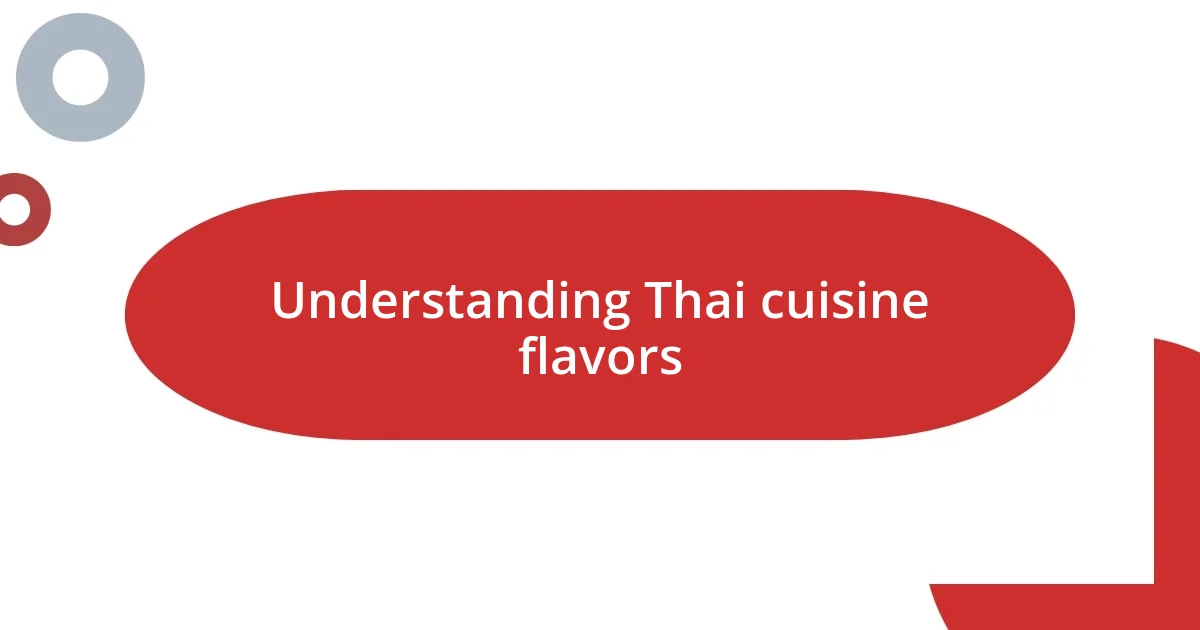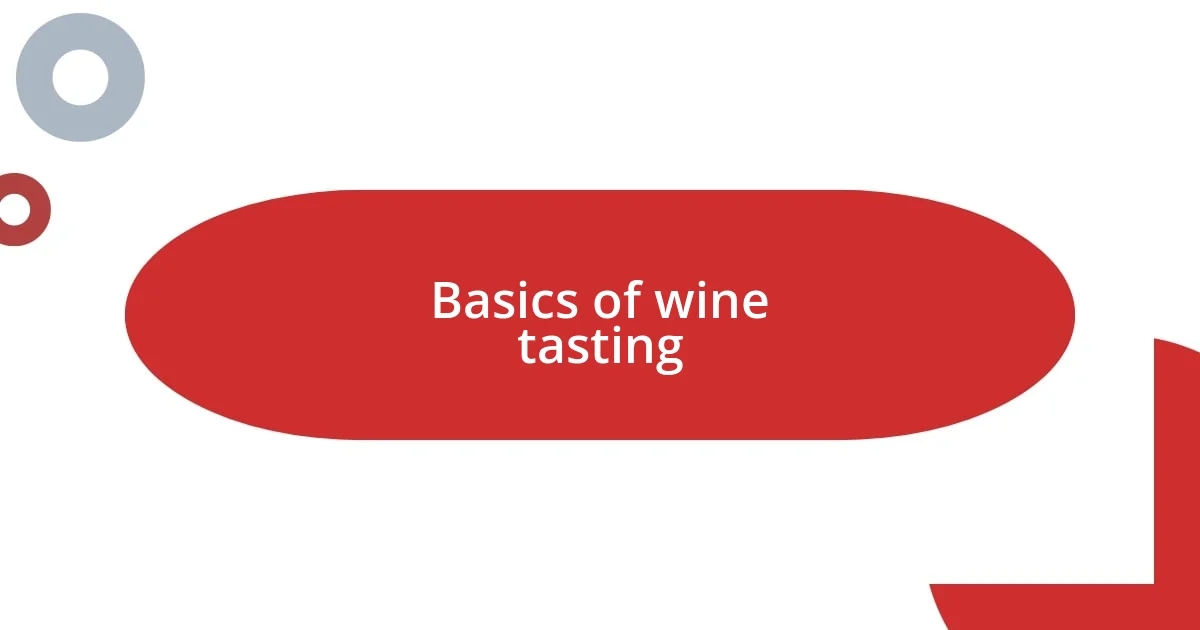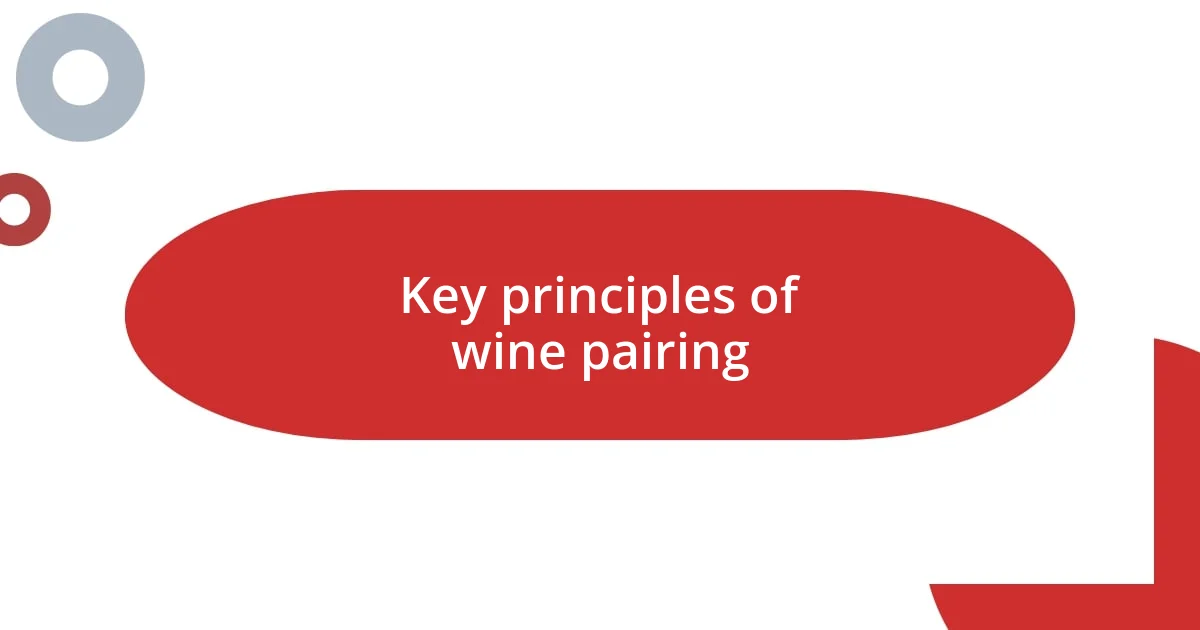Key takeaways:
- Thai cuisine features a complex blend of sweet, salty, sour, and spicy flavors that vary by region, enriching the dining experience.
- Key principles of wine pairing include matching intensity, considering flavor profiles, and using acidity to enhance the overall meal.
- Experimenting with unconventional pairings can lead to surprising and delightful culinary discoveries, enhancing the flavor experience of both food and wine.

Understanding Thai cuisine flavors
Thai cuisine is a vibrant tapestry woven from a symphony of flavors—sweet, salty, sour, and spicy. I remember my first taste of Pad Thai; the contrast of a tangy tamarind sauce with the slight sweetness of palm sugar was an unexpected revelation. It made me wonder: how can a single dish evoke so many sensations at once?
Each ingredient plays a crucial role in this intricate flavor profile. For instance, fresh herbs like cilantro and mint can awaken dishes with their bright fragrances. The first time I tasted a bowl of Tom Yum soup, the boldness of lemongrass and the heat from bird’s eye chilies sparked a delightful chaos in my mouth. It’s this balance and interplay that keeps me reaching for more!
Moreover, the regional variations in Thailand add to the complexity—we’ve got the creamy coconut curries of the south versus the fiery dishes of the north. I vividly recall savoring a rich Massaman curry, its warm spices wrapping around my palate like a cozy blanket. Does it get any better than this dynamic blend of textures and flavors? It’s experiences like these that make understanding Thai cuisine an adventurous journey!

Basics of wine tasting
Wine tasting is an art that involves engaging all your senses. I still remember the first time I swirled a glass of rich Cabernet Sauvignon. The deep aromas enveloped me, inviting curiosity before the first sip. It’s not just about tasting; it’s about experiencing the wine fully.
Here are some key basics to keep in mind while tasting wine:
- Look: Examine the wine’s color and clarity. A vibrant hue can indicate youthfulness.
- Swirl: Gently swirl the wine in the glass to release its aromas. This step is crucial to awaken the hidden scents.
- Smell: Take a moment to inhale deeply. Identify aromas—fruits, spices, or even earthy notes that can tell a story about the wine’s origin.
- Taste: Take a small sip and let it coat your palate. Notice the flavor profile—sweet, acidic, tannic, or salty.
- Feel: Consider the mouthfeel—Is it silky, rough, or bubbly? This adds to the experience.
- Finish: Pay attention to the aftertaste. A long finish can be a mark of quality.
Engaging in this multi-sensory experience brings a surprising depth to wine appreciation. I find it fascinating how a simple act of tasting can transport you to different regions, just like savoring a spoonful of vibrant Thai curry. The thrill lies in discovering how these elements not only stand alone but also pair beautifully with the flavors of food, opening the door to memorable dining experiences.

Key principles of wine pairing
Pairing wine with food, especially Thai cuisine, relies on a few key principles that can elevate the dining experience. One fundamental idea is matching the intensity. For instance, a robust red can overwhelm delicate dishes, while a light, crisp white may not stand up against spicy curries. I recall pairing a zesty Riesling with a spicy green curry; the wine’s sweetness danced harmoniously with the heat, creating a delightful balance that made each bite a new experience.
Another vital principle is considering the flavor profiles of both the wine and the dish. When I first tried a tropical Sauvignon Blanc alongside Pad Thai, the wine’s citrus notes brought out the dish’s tamarind sweetness in a way that was truly enlightening. This interplay between complementary flavors can paint a richer picture on your palate, enhancing the essence of both the food and the wine.
Lastly, acidity can play an instrumental role in wine pairing. High-acid wines like a Pinot Grigio can cut through creamy dishes, providing a refreshing contrast. I once savored a coconut-based curry paired with a lively white, and the interaction was nothing short of magical. It’s fascinating how a small adjustment in your pairing choices can lead to moments of culinary joy that linger in your memory.
| Pairing Principle | Description |
|---|---|
| Intensity Matching | Balance the strength of the wine with the dish; robust wines with hearty dishes and light wines with delicate flavors. |
| Flavor Profile | Consider how the wine’s flavors can complement or contrast with the dish’s ingredients for a harmonious experience. |
| Acidity | High-acid wines can enhance rich or creamy dishes by providing a refreshing contrast that amplifies the overall flavors. |

Choosing wine for spicy dishes
When it comes to choosing wine for spicy dishes, the challenge often lies in balancing the heat with the wine’s profile. I remember attempting to pair a fiery green curry with a bold Syrah, only to realize that the wine’s tannins clashed with the dish’s spice. This experience taught me that picking a wine too heavy for a spicy meal can lead to an uninviting tasting experience. Instead, I’ve found that a slightly sweet or fruity white can serve as a perfect companion, soothing the palate without overpowering the vibrant flavors of the food.
Have you ever thought about the role of sweetness in wine? I tend to gravitate towards off-dry Rieslings or Gewürztraminers when I’m faced with spicy dishes. Their natural sweetness not only complements the heat but also enhances the intricate flavors of the meal. I vividly recall enjoying a spicy peanut satay with an off-dry Riesling; the wine’s sweetness and acidity wrapped around the spice, creating a harmonious synergy that was truly unforgettable. It’s those kinds of pairings that make dining an adventure—each sip and bite offers a new layer of flavor.
Acidity in wine can also significantly influence how well it pairs with spicy food. I’ve often opted for a refreshing Sauvignon Blanc, which can tackle the richness of coconut milk and elevate the overall experience even further. The last time I paired it with a spicy basil fried rice, I was struck by how the wine’s bright acidity cut through the heat, leaving my taste buds refreshed rather than fatigued. It was a reminder of how well-chosen wine can enhance the pleasure of a meal, making each gathering an opportunity to discover something new.

Experimenting with unique pairings
I’ve always found that experimenting with unique pairings can lead to delightful surprises. For instance, one evening I decided to try a fruity rosé with a spicy yellow curry. To my surprise, the rosé’s berry notes married beautifully with the dish’s spice, creating a sensation that felt like a summer festival on my palate. Why hadn’t I thought of that before? It made me realize that stepping outside the conventional pairing rules can open doors to unexpected flavor experiences.
Recently, I also ventured to pair a sparkling wine with a vibrant green papaya salad. The bubbles in the wine danced around the crispness of the salad, accentuating the zesty lime and garlic elements. It was exhilarating—each sip added a new layer of freshness that complemented the dish perfectly. Have you ever tried bubbly with something you wouldn’t normally consider? Sometimes, the most unconventional decisions yield the most memorable outcomes.
One of my favorite experiments involved a deep, rich Malbec paired with a spicy Massaman curry. Initially, I feared the wine would overpower the dish, but instead, its dark fruit flavors melded with the curry’s complexity, enhancing the overall experience. I felt like a culinary explorer, discovering a blend of cultures through each bite and sip. This journey of tasting has shown me that allowing room for creativity in our pairings can lead to flavorful revelations—who knows what you’ll uncover next?















